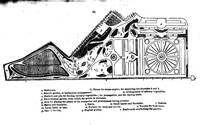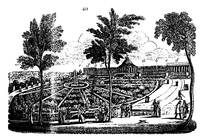179.he botanic garden at Brussels occupied a small space, and contained very few plants, till 1826, when it was removed to a new site on the north of the city. It is now (1848) of considerable extent, and contains a magnificent range of green and hot-houses 400 feet long, ornamented with a rotunda and porticoes, with columns of the Ionic order (fig. 40.); pits, frames, and fountains. One striking feature of this botanic garden is, that, from the circumstance of its running parallel, for upwards of one third of a mile, with the boulevard, or rampart walk of the town, which overlooks it, the hothouses and the whole garden may be completely seen by the public without their entering it Besides the magnificent range of hothouses, there are low frames with curvilinear roofs (a); low frames with straight sashes (b); six fountains (c); and a handsome flight of steps (d) from the boulevard (e, e). A plan of this garden (fig. 41.), exhibiting the details, is given on the opposite page. The range of hothouses at this garden, including the pits and architectural appendages in front of them, forms a very splendid elevation (fig. 42.). The arrangement, as far as can be judged from the plan, is eligible. There are comparatively few plants of large size in this garden. In the stoves there were some very fine specimens of palms, but some of them were entirely destroyed during the revolution previous to the accession of King Leopold, as the Dutch were in possession of the houses and gardens during the greater part of the contest. A large plant of Strelitzia augusta, supposed to be the finest in Europe, was cut to pieces by the soldiers. The New Holland plants in this garden are generally of very large size.





